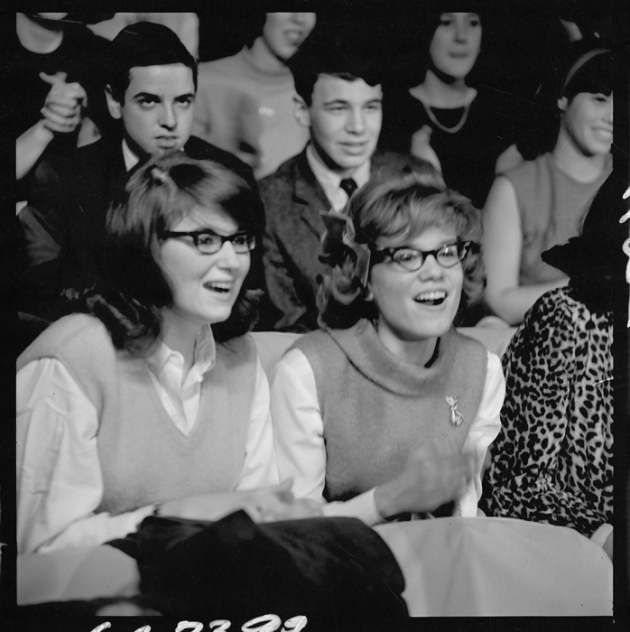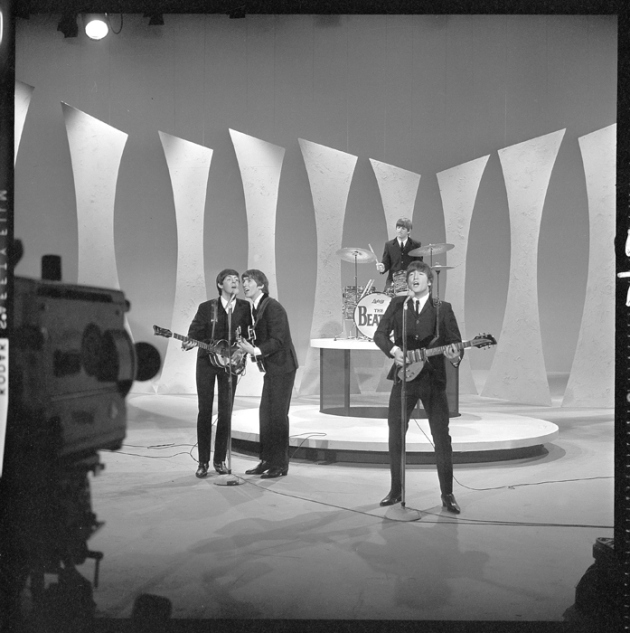“She Loves You”: The Beatles, Girl Culture, and The Ed Sullivan Show
 February 9, 1964: a dark-haired girl gazes into the box perched in her family’s kitchen. Paul McCartney’s face, framed in a close-up on that TV set, shines on the screen. The girl doesn’t take her eyes off him and his mop-topped cohorts while her younger sisters lean forward and smile, equally mesmerized. Their dad, however, looks down with just a hint of disapproval, as the family watches the Beatles perform on The Ed Sullivan Show.
February 9, 1964: a dark-haired girl gazes into the box perched in her family’s kitchen. Paul McCartney’s face, framed in a close-up on that TV set, shines on the screen. The girl doesn’t take her eyes off him and his mop-topped cohorts while her younger sisters lean forward and smile, equally mesmerized. Their dad, however, looks down with just a hint of disapproval, as the family watches the Beatles perform on The Ed Sullivan Show.
This home movie is part of the footage compiled on CNN’s “The British Invasion,” a one-hour segment of the 10-hour series, The Sixties, which will air in May. The episode premiered January 30, 2014, in advance of the 50-year anniversary of a landmark moment in American cultural history: the Beatles arrival at JFK Airport and their subsequent performance on the Sunday-night standard.
CNN’s documentary recognizes the importance of the televised event as ushering in the British Invasion, an onslaught of English bands that pervaded the musical landscape of the Baby Boomers. These British bands essentially re-introduced American rock and roll but this time with an English twist. Interviews with rock critics and musicians celebrate the cross-cultural exchange between African-American artists (like Chuck Berry and Smokey Robinson) and English rockers (like the Beatles and the Rolling Stones).
But it wasn’t just a boys’ club: the footage of the American girl-viewer and her sisters reminds us of the importance of those girl audiences. In fact, the Beatles’ relationship with girl culture is crucial to understanding their break-through Ed Sullivan moment.
Ed Sullivan brandishes his arm, introducing “The Beatles!”, words that are drowned out by the roar of girls’ screams that will accompany the band. This performance united an entire generation of young people, turned on by the newness of the Beatles sound. The Liverpudlian lads’ fresh youthfulness invigorated a nation still mourning the death of a young, promising president. But the Beatles’ special appeal to girls helps explain why John, Paul, George, and Ringo became the vessels into which so much emotion from female youth was poured.
Prior to 1964, the Beatles had covered a number of girl-group songs, singing through a girl’s point of view in tunes like the Marvelette’s “Please Mister Postman” and the Shirelles’ “Boys.” During The Ed Sullivan Show, they sang a Lennon/McCartney original, “She Loves You.” Jacqueline Warwick (“You’re Going to Lose That Girl” 2000) and Barbara Bradby (“She Told Me What to Say” 2005), recognize how the Beatles act in this song as intermediaries in a relationship between two other people, encouraging “you” to trust in “her” love:
You think you lost your love,
Well I saw her yesterday.
She says she loves you,
And you know that can’t be bad,
Yes, she loves you,
And you know you should be glad.
This position, that of a kind of girlfriend with relationship advice, mirrors the perspective offered by girl-groups, and, as Bradby argues, encouraged the public expression of female desire.
In short, the Beatles spoke to girls in their own language.
In a fascinating twist, the Beatles continue their conversation with these girl groups in songs like “I Want To Hold Your Hand” and “I Saw Her Standing There” (also performed during The Ed Sullivan Show). Bradby suggests that “the Beatles’ frequent assertions of ‘I love you’ can be seen as a direct response to the repeated questions and requests for men to voice these words, by the Shirelles and other groups.”
So the Beatles appealed to girls through familiar and comforting girl-group discourse, but they also became the “bad boys” who worried parents. Such rebelliousness, however, was managed through androgyny, not conventional masculinity. Their hair, which shook as they “woo”-ed girls, was considered long and girlish, rebellious and untrustworthy. Their lanky bodies, accentuated by fitted suits, contrasted starkly with the adult male body of 1950s icon, Elvis Presley. The soon-to-be-famous Beatle boots were sleek and pointed, suggesting an artistic sensibility.
On The Ed Sullivan Show that Sunday evening, these haircuts, suits, boots, and boyish bodies were not just alike in androgyny; they were also simply that— alike. Such matching images were complemented by tight harmonies literalized by close body positions. Similar to their girl-group predecessors, as well as the Everly Brothers, the Beatles shared microphones in two-at-a-time pairings. In Meet the Beatles, Steven Stark observes how McCartney’s left-handed bass playing made intimacy even more apparent while creating a pleasing mirror image. Strumming and singing together, they were so close they could almost kiss. Close-up shots that linger on their mouths and faces may have encouraged girl viewers to imagine their own Beatle kiss.
This brotherly togetherness facilitated the image of intimate friends, whose carefree playfulness promised freedom. Famously, Barbara Ehrenreich, Elizabeth Hess, and Gloria Jacobs (“Beatlemania: Girls Just Want to Have Fun” 1992), have theorized the relationship between girls’ screams for the Beatles and sexual desire. They argue that this collective expression had as much to do with girls’ desire to break with restrictive gender expectations as it did with their adoration for the Beatles themselves. Watching these girlish boys on Ed Sullivan—boys who were in conversation with them!—showed girl viewers new possibilities.
The Beatles promise of new possibilities continues to account for their persistence in girl culture today. I will present research in this area at the Penn State Altoona academic conference focused solely on the Beatles from February 7-9, 2014. (Apparently, even academics are not immune from the urge to commemorate the landmark event!) What I find over and over again in online communities of 21st-century fangirls is that the Beatles’ androgynous gender performances, which promised fun, friendship, and freedom, still excite female youth today as they did for girls in the 1960s.



